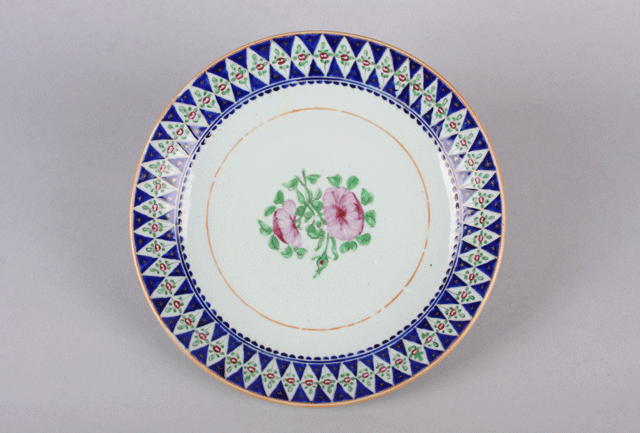
2012.91.97, porcelain plate made for export; late 1700s
Eason Eige collection; photo by B. Bernard

2012.91.97, porcelain plate made for export; late 1700s
Eason Eige collection; photo by B. Bernard
The plate shown above looks like something you can buy today— but unlike today's mass-produced dinnerware, it was hand-painted. In this part of the online exhibit we tell the story of how Chinese mass-produced but hand-painted porcelain came to dominate the world's trade in fine dinnerware, and how the rest of the world csame to mass-produce table pieces inspired by the Chinese originals.
"China trade ware" (or "Canton ware," as we know it today) was first exported in
the late 1600s. At that time the trade pieces were mostly the blue and white
porcelain the West had known since the Ming dynasty, but with a twist: the
Chinese now created pieces designed for the Western market. European forms such
as mugs, soup tureens, and candlesticks were unknown
in China, so models were sent to the Chinese potters to be copied.
As global competition heated up, the Chinese made their export wares more
colorful.
One item from this ongoing global competition is shown below: an inkstand,
found in
every well-off household in the 1700s. If your personal inkstand was from
China, it was a clear sign that you were very well off!
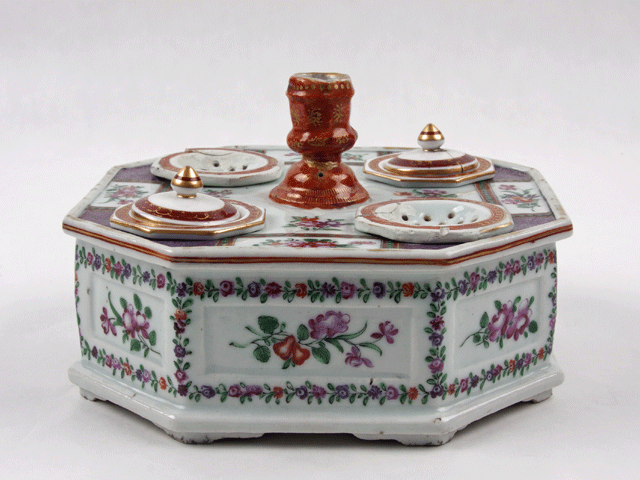
2012.91.251, ink stand made for export; late 1700s
Eason Eige collection; photo by B. Bernard
To find out more about the ink stand, please click
here.
In the early 1700s, during the Kang Xi Emperor's reign, Chinese trade ware production was reorganized to cater almost exclusively to the West, where the practice of referring to porcelain as "china" became the norm. Trade increased to such a level that low-quality "china" was called "ballast ware" by merchant seaman. Rugged and waterproof, such "china" was stored in the lowest holds of sailing vessels and acted as ballast during the voyage back to Europe or America. Of course, finer pieces of "china" (such as the plate and ink stand shown above) were shipped more carefully!
Canton Ware was made and fired in Jingdezhen—the center of porcelain manufacturing since the Song dynasty, when it became the official Imperial kiln. The proximity of rich deposits of kaolin made it an ideal location for long-term production. (A visit to Jingdezhen today, more than 1,000 years after ceramic production began, reveals a town still dominated by this single craft.) Porcelain for the foreign trade was not painted in Jingdezhen; instead it was sent by the East India Trading Company to the seaside port of Canton (Guangdong) for final decorating. Thus the name "Canton" alludes as much to the decoration and design on the ware as it does to the port of export.
Canton Ware became part of U.S. history shortly after the American Revolution. In towns up and down the East Coast, families eagerly awaited shipments of porcelain from the Far East. George and Martha Washington favored Canton blue and white dinner and tea sets, and such porcelain could be found in the White House once the new president's residence was completed. Canton Ware was equally popular with the merchant class, eventually becoming an integral part of elite public and private life in America. For the first half of the 1800s, the United States was the principal market for Chinese export porcelain. Not the only market, however: in Europe, and in all countries based on European political and social principles, the first choice for supper, teatime, or coffee service was Chinese porcelain.
Even among those rich enough to purchase Canton Ware, not all porcelain was
created equal. If you click on the thumbnail below, you'll learn about
"armorial porcelain."
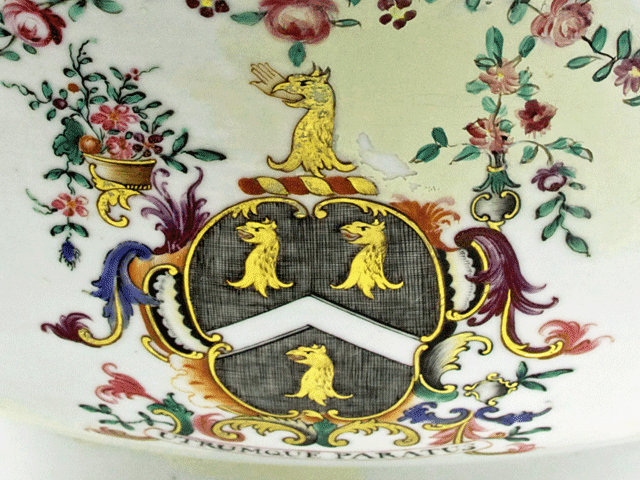
Armorial porcelain (click on picture to enter)
The Opium Wars of 1839 to 1860 interrupted the export of porcelains, but did not end the demand for them. In 1890 the United States government required all imports to be marked with their country of origin; porcelain marked "CHINA" or "MADE IN CHINA" postdates that year. The U.S. Stamp Act of 1894 specifically mandated the imprint "Made in China" on export porcelain, but as late as the early 1900s some Canton ware still arrived with only paper labels.
To see examples of Chinese pieces created for the Western market, please click on a photo below.
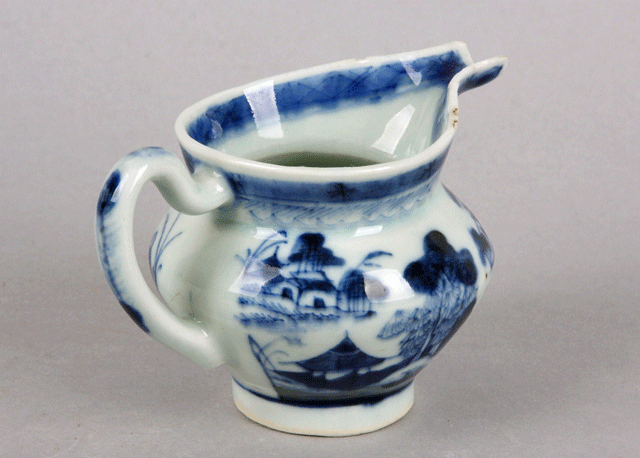
Blue and white ware (click on picture to enter)
In the mid-1800s, Chinese ceramicists developed new painted styles—many quite colorful—to go with the vessel forms preferred by the West. One such style is shown in the next picture.
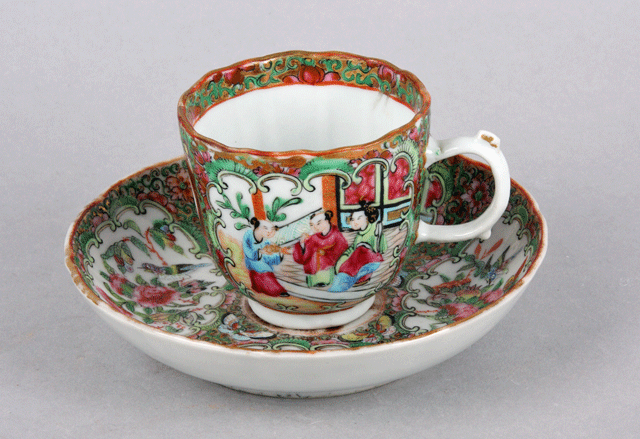
Rose Medallion porcelain (click on picture to enter)
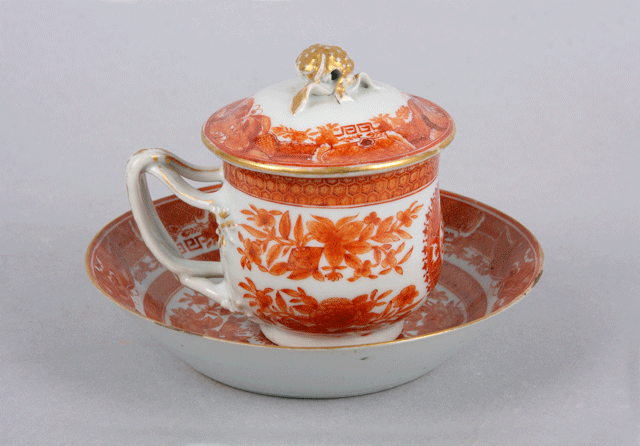
Some other styles (click on picture to enter)
Success often breeds imitation, but it took many years for Western ceramists to
develop suitable imitations of Chinese ceramics.
Many early imitations were actually earthenware or stoneware decorated with
tin-based glazes. Imitations of
Chinese blue and white ware include willow ware (England), Delft ware (Holland),
and Talavera ware (Mexico). In order to remain competitive in a changing global
market, Chinese potters began making highly colored porcelain with gold
highlights. Be sure to visit
the next page in this section, featuring
pieces inspired by—and outright imitations of—Chinese porcelain.
See source code for photo credits and copyright information. Page last revised on March 4, 2016. Please report problems to toh@unm.edu